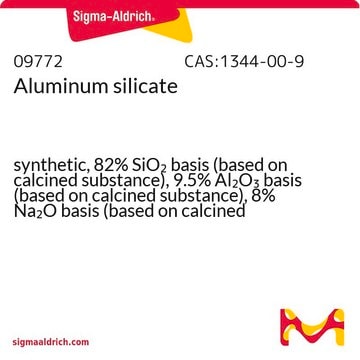556130
Bismut
pieces, 1-12 mm, 99.999% trace metals basis
Synonym(e):
Bismuth element, Bismuth-209
About This Item
Empfohlene Produkte
Dampfdruck
<0.1 mmHg ( 20 °C)
Assay
99.999% trace metals basis
Form
pieces
Widerstandsfähigkeit
129 μΩ-cm, 20°C
Partikelgröße
1-12 mm
bp
1560 °C (lit.)
mp (Schmelzpunkt)
271 °C (lit.)
Dichte
9.8 g/mL at 25 °C (lit.)
SMILES String
[Bi]
InChI
1S/Bi
InChIKey
JCXGWMGPZLAOME-UHFFFAOYSA-N
Suchen Sie nach ähnlichen Produkten? Aufrufen Leitfaden zum Produktvergleich
Verwandte Kategorien
Allgemeine Beschreibung
Anwendung
- Research Update: Bismuth based materials for photovoltaics: This research update briefly summarizes the developments in bismuth materials for use in photovoltaics, focusing on bismuth-based perovskites and bismuth halides (Cates & Bernechea, 2018).
- Bismuth-based photocatalysts for solar energy conversion: This study reviews bismuth-based photocatalysts, which are gaining attention for their efficiency in solar energy conversion (Wang, Wang & Huang, 2020).
Lagerklassenschlüssel
11 - Combustible Solids
WGK
nwg
Flammpunkt (°F)
Not applicable
Flammpunkt (°C)
Not applicable
Persönliche Schutzausrüstung
Eyeshields, Gloves, type N95 (US)
Analysenzertifikate (COA)
Suchen Sie nach Analysenzertifikate (COA), indem Sie die Lot-/Chargennummer des Produkts eingeben. Lot- und Chargennummern sind auf dem Produktetikett hinter den Wörtern ‘Lot’ oder ‘Batch’ (Lot oder Charge) zu finden.
Besitzen Sie dieses Produkt bereits?
In der Dokumentenbibliothek finden Sie die Dokumentation zu den Produkten, die Sie kürzlich erworben haben.
Kunden haben sich ebenfalls angesehen
Unser Team von Wissenschaftlern verfügt über Erfahrung in allen Forschungsbereichen einschließlich Life Science, Materialwissenschaften, chemischer Synthese, Chromatographie, Analytik und vielen mehr..
Setzen Sie sich mit dem technischen Dienst in Verbindung.







